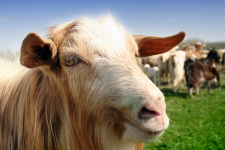The Key(word) to Success (for Photographers)
Posted: October 26, 2010
Keywording skills are as important to your success in microstock as your skills with your camera. Attaching the correct words to an image may be a bit tedious, but it’s an essential investment in the images that you worked so hard to create.
by Ellen Boughn in Ellen Boughn, Photography
Keywording skills are as important to your success in microstock as your skills with your camera. Attaching the correct words to an image may be a bit tedious, but it’s an essential investment in the images that you worked so hard to create.
Is a photo a great stock photo if no one can find it? Yep, it’s still a great photo but it won’t make any money.
 Take care when labeling objects in the background that are significant. The animals in the background here should be ignored when keywording. © arosoft/Crestock[/caption]
Take care when labeling objects in the background that are significant. The animals in the background here should be ignored when keywording. © arosoft/Crestock[/caption] It would be incorrect to keyword this photo with the words "ocean" or “beach”. The shell could be in a studio or perhaps it is on a beach but the photo doesn't show the ocean or a beach. © aldzer/Crestock [/caption]dictionary to help you identify the correct word. Contact someone whose English language skills are excellent. Yes, it's time consuming, but it’s important work.
It would be incorrect to keyword this photo with the words "ocean" or “beach”. The shell could be in a studio or perhaps it is on a beach but the photo doesn't show the ocean or a beach. © aldzer/Crestock [/caption]dictionary to help you identify the correct word. Contact someone whose English language skills are excellent. Yes, it's time consuming, but it’s important work.• Too many keywords. Don’t attach a keyword to every element of a photo. Every image of a person that shows their entire face is going to indicate that they have lips. Only use lips when that is a key element of the image. Another common keywording mistake is to name every single item in the photo. Look again at the close-up of the goat above. Those blurry things in the background on the right of the photo may be horses, but this is not a photo of a horse and should not be keyworded thus.
• Keyword Spamming. One of the most commonly searched keywords on the Internet is sex. The word business is also equally popular in microstock search [caption id="attachment_7841" align="alignright"] This speeding taxi might look like it’s headed for an accident but it’s not a photo of an accident (the photographer has used correct keywords). © corepics/Crestock[/caption]words. But if you think that adding those keywords to images not related to sex or business will help you, you are wrong. You will be kicked off the site for spamming.
This speeding taxi might look like it’s headed for an accident but it’s not a photo of an accident (the photographer has used correct keywords). © corepics/Crestock[/caption]words. But if you think that adding those keywords to images not related to sex or business will help you, you are wrong. You will be kicked off the site for spamming.
• Inaccurate action. I found a photo on another site of a moose standing in a field. I had searched on the word camping. No doubt the photographer had been camping when he photographed the moose but the moose wasn’t “camping” and so the keyword was incorrect.
A few of the most important Crestock keywording rules:
- Captions and keywords must be in English.
- Each image must have at least 10 keywords, up to a maximum of 50.
- Check your spelling!
- Essential information in your photo caption must also be repeated in your keywords.
- Correctly identify all geographical locations, types of plants and animals, kinds of machinery or processes that are prominent and/or relevant in the image.
- Include ages and ethnicities of models.
- Do not use articles and prepositions such as the, in, on, a, and, this, but etc.
- Only include colors as keywords it they are a central or important part of the picture.
- Use adjectives. Clients are often searching for images with a certain feeling or mood like happy, sad, energetic, harmony, etc. These kinds of keywords are popular. So, when you have a great image of a happy family, you can expand your keywording further to include other descriptive terms like smiling, cheerful and joyful.
- Don’t exaggerate. Keywords like fantastic, euphoria, spectacular, etc., should be avoided.
- Do not use opposites. Example: a winter scene with the keyword summer is not helpful.
- Don't include words like photo, photograph, image or picture, as these could apply to every image in the collection. Only use them if they are relevant to the content of your image (e.g. an image of a mother holding a portrait of her child).
Good keywording may be a bit tedious, but it’s an essential investment in the images that you worked so hard to create.
